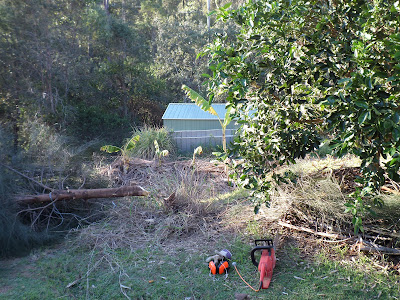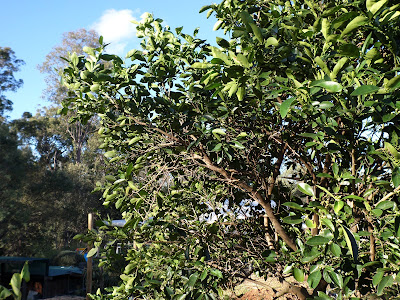Think of it as rewarding the soil microbes for growing anything on your land in the first place. You can do this by using livestock, recycling plant material through their dung. Or you can use the plant material itself. Never remove from your landscape, what it had the wherewithal to produce. That's like robbing your own bank account. You'll eventually spend the land itself.
Orange blossoms - looks to be an abundant harvest
Which is what carbon pathways are all about. It's a permaculture term, which plans to design excess carbon into the landscape, and recycles it back into the soil. Being cyclical in nature, it's designed to continue giving, indefinitely.
I'm constantly dealing with carbon in our garden, and I probably haven't given it as much credence as I should. At least from it's point of origin. You see, we have an abundance of eucalyptus, acacias and ironbark trees, which David and I are constantly having to deal with. We should have put them to work as a resource, a lot sooner than we have. At least now though, we see it's an asset to be utilised.
When David was taking down the old trellis recently, for example, I did some more mulching of our Leng Navel. It's a different tree to the Washington Navel, I gave the same treatment to a few months ago.
Leng Navel
We always have branches and twigs to spare, and using them up as mulch, really protects the soil from drying out, under the orange tree. It also stops the brush turkeys from digging up the roots. I just break up the branches and it's quite a calming activity, despite it's physical requirements.
It still needed a finer mulching material on top however, which came in the way, of another tree. Actually, it lived just next to the orange itself.
Leng Navel (centre) Hilltop chicken coop (right)
Casaurina (left)
It's a casuarina tree, and it was planted roughly the same time as the orange. It's better suited to our dry climate, than the orange tree was, and it's sole purpose was to protect the citrus, from the intense afternoon sun. Which it has done a successful job of doing. This orange tree is a lot bigger than it's sister Washington Navel, planted at the same time.
But now the casuarina is dwarfing it's citrus companion. Left unchecked, it could become a sooty mould problem. We've already seen some of the branches die on the side that receives the most shade.
Removed
So out came the chainsaw, and the safety equipment. In a matter of minutes, the casuarina tree came down. With spring just around the corner though, we're hoping it will re-shoot, or coppice. That way, we will have more mulching material to place around the tree in another year's time.
Taking out the tree, is only the first step ~
now what to do with it?
That casuarina was about 8 years old, so it had a lot of carbon material to give. And use it, we did! Casuarina can sequester nitrogen from the atmosphere, so it's need-like leaves, are high in nitrogen. It can also reduce pH in alkaline soils, making them more acid for things like blueberries and strawberries.
I actually used most of it's trunk as garden edging/hugelkultur, for a nearby rose bed. It had provided beautiful flowers in the past, but now it was being overtaken by grass. So I'm in the process of using most of the Casuarina trunk, and some eucalyptus trunks we have laying around, for that project. It will then be covered in casuarina leaves. I hope to report on my roses at a later date.
Mulched with casuarina leaves
Of course, I also used a lot of leaves and branches under the orange tree. There was so much material to use up, I had enough to put around both orange trees, and a carob tree too. Not to mention the rose bed.
In the image above and below, you can see the Leng Navel, now has access to full sun.
A balance of sunlight
Those bare branches should fill up nicely with new leaves, and there's enough thick mulch around the tree, the ground shouldn't be exposed to intense summer heat. If the casuarina stump doesn't re-shoot, I have plans to grow pigeon peas and lemon grass, to replace as mulching plants.
Actually, this area will soon be filled with a range of new mulching plants. As we want to continue feeding the trees, which feed us.
Opportunities abound
Just below the recently felled, casuarina tree, is a new banana pit. I look forward to sharing more on that project, as it develops further. We're hoping it will become quite a productive area.
The theme to take away from this post however, is to think more about using all the plants on your property. Whether they be growing wild and you're forever having to deal with them (native trees in our case) or those plants you propagate, with the intention to chop and drop as perpetual mulch, to feed the soil - start thinking how diverse you can make the carbon pathways, across your landscape. How can you increase it, by using it up and increasing it again?
The more carbon materials you can sequester back into the soil, the more resilient your soil will become. Plus, you won't have to rely exclusively on bales bought from the store, to protect your soil. Remember the bank account analogy. By making more deposits than withdrawals, you will soon be richer in abundance.









Great post! What I like about your blog is that you not only write about what you're doing, but you THINK about it as well and always put that something extra into the whys and wherefores of a post.
ReplyDeleteI love the mulch around the orange trees! I'm starting to build mine up now with fallen twigs and branches raked from the walking tracks. I burn off a lot....far too much....and you are making me feel guilty, although I do collect the ash regularly and return it to the bush by the shovelful, to return some of the minerals.
Thanks Bev, but it's hard not to think about a landscape as challenging as our own. Like your backyard, its difficult to garden in bush soils. We need to put our thinking caps on. ;)
DeleteExcellent idea to keep your walking paths clear, and use the material under the trees at the same time. Turning those necessary chores, into an opportunity to feed your edible plants. It's a win-win.
In relation to burning, it's advantageous to consider what returns can be gained, by maximising carbon into the soil, first. It might be that some burning is required afterwards. Like all things in land management, it's a sliding scale of inputs and feedback. We strategize for maximum benefit. :)
Such good ideas Chris. I have used mulberry tree prunnings in much the same way but would not have thought to do it with a casurina. I have a small she-oak growing in one of my indigenous garden areas. It is only small yet and appeared due to nature's magic without any help from me, so I have yet to identify what type it is. Now after reading your post I am looking forward the time I can use its litter as mulch for the blueberries I want to plant in the future. My husband took all the dead leaves of the bananas last week and put them through the mulcher ready for me to put on the garden. Small but exciting steps toward creating a closed system.
ReplyDeleteAnother fan of mulberry here! There is plenty of carbon to gain from fast-growing mulberry. I always love to hear how others are using this amazing tree too.
DeleteI don't know where your casurina tree has popped up in the garden, but it would be fantastic, if you had enough space around it to plant a ring of blueberries bushes. It would be self mulching! It might also stagger your blueberry crops as the sun migrates through the season. It sounds like a fantastic opportunity, nature has given you.
I love those kinds of surprises in the garden. :)
Food for thought, thanks Chris. I am not sure I could plant a ring because that because I have some planted by the fairies Bacon and Egg pea plants growing nearby on one side. However I think I might be able to plant a couple of blueberry shrubs on one side.
DeleteI knew you'd pick the design perfect for you location. Thumbs up. :)
DeleteChris - you are such an achiever! I love how you practice what you preach.
ReplyDeleteShucks, you made me blush. But I so love doing this kind of work in the yard. It's finding the time, which is the most challenging part. :)
DeleteI love this post Chris! It related to the next part of holistic management as well, knowing your water cycle, mineral cycle, energy flow and community dynamics. Thanks for sharing what you're doing and why, its a great inspiration :)
ReplyDeleteIt all ties together, doesn't it Liz. We're very fortunate to be able to learn all this stuff, to benefit our landscapes. Every little bit helps. :)
DeleteMy favorite beverage addition in summer or when I have a slight stomach ache is orange blossom water. I am thinking of getting my own orange tree for indoors just to make my own but its pretty cheap to buy in the store. I suppose you make it like rose flower water in case you are interested. I know my grandmother used to make it in a proper still.
ReplyDeleteI love your use of mulch-the materials you employ that would otherwise be taken for granted.
I like to use what we have, because when I look around, it's actually quite a lot. Plenty of mulching material everywhere.
ReplyDeleteMmmm...That orange blossom water sounds nice. I'll have to look further into it. And making it in a still, sounds like a real art form. Bet it tasted awesome though. :)